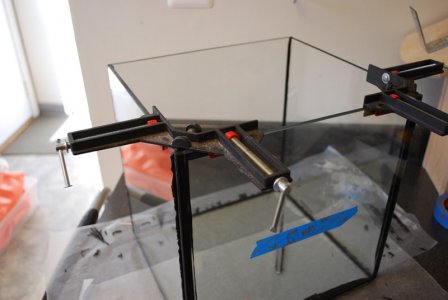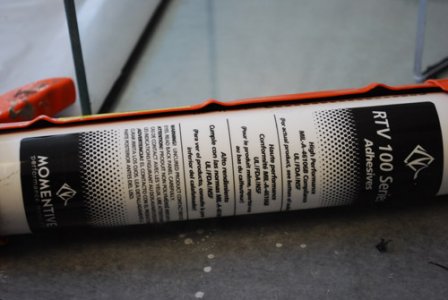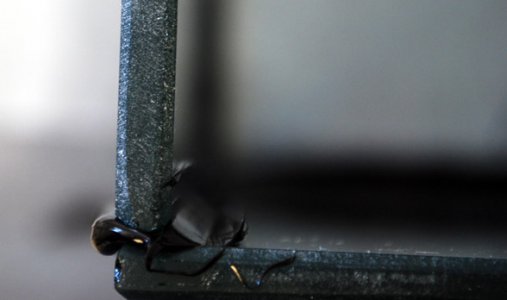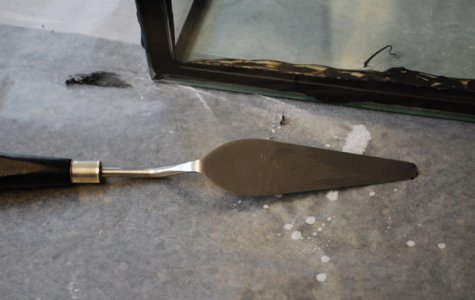Reef Developer
New member
There's a lot of info on working with acrylic, less so for glass. Acrylic is an interesting material with a lot of flexiblity in shaping and cutting. Unfortunately, its harder to get than glass.
After a few projects with acrylic (sumps mostly) I figured its time to try glass. The end goal is a nano tank and sump. As a test run I'm making the basic sump, roughly 1' on each side. The tank will be a more atypical size, around 15"w x 15"t x 12"d.
I'm writing this in order to provide my lessons learned, definitely not from the "best way" since I am new to working with glass.
Regarding the gap between glass, I was going to try to use toothpicks as spacers. The problem is that your have a void left after removing the toothpicks. Instead I relied on feel and look to approximate a gap of ~1/16". Since this silicone is so thick, you have a certain amount of play. I'm not sure if this is how the pros do it or not. I suspect that with time and experience spacers are not needed and they simply go by feel.
My biggest concern with glass is strength. Acrylic gives you that super strong chemical bond at the joint. When you break a sample piece of acrylic the pieces break before the joint does. With glass, basic silicone just doesn't seem that strong. But again, this RTV stuff is different.
Injecting some math to make me fill better about strength, a 1 cubic foot tank holds ~7.5 gallons. 7.5 gallons holds ~60 lbs of water. There's 8 seams where the glass meets. 8 seams x 12" = 96" linear inches. 60 lbs \ 96" = .6 lbs / linear inch. Thats nothing! Doing a test pull on the 4" piece of acrylic I don't think it will have any problem lifting the empty tank with about 10lbs of glass. When everything's dry I'll give it a final test. But my point is as far as I can tell this stuff is STRONG.
But understand that as a tank gets bigger, there's more force in each seam. In other words, the math I did above doesn't scale up proportionately.
In the end, I'm not sure if I'm going to make the nano display tank out of acrylic or glass. Both have their benefits. Some of the online places that sell acrylic want a lot, like $25/sf. Crazy. Glass, otoh, is nice because once everything is glued up and dried your done. Acrylic requires you to clean and sand and polish the ends.
Hope this helps anyone thinking of jumping into a glass build!
After a few projects with acrylic (sumps mostly) I figured its time to try glass. The end goal is a nano tank and sump. As a test run I'm making the basic sump, roughly 1' on each side. The tank will be a more atypical size, around 15"w x 15"t x 12"d.
I'm writing this in order to provide my lessons learned, definitely not from the "best way" since I am new to working with glass.
- Photo 1: Here's where I'm today. Putting the last pane on. Using 90° clamps. These helped a lot to keep the panels aligned and fixed in place. However, this silicone (Momentiv RTV100 series) is unlike any silicone I've used before and is TOUGH. Point is that I'm not even sure I would need the brackets since the surface tension and viscosity (thicker than silicones from Home Depot) meant the panels stayed where I put them. But the same could probably not be said for larger tanks.
Also, you can see where the silicone oozes out of the seam. After drying this cuts off with a razor cleanly.
- Photo 2: The RTV 100 silicone. Again, tough stuff. If you look in the 1st photo you may be able to see a small piece of acrylic sticking up....using this as a test piece to pull off and see if I could lift the whole tank with. If your going to build a tank don't mess with off the shelf stuff from big box stores.
- Photos 3 & 4: For the first pieces, bottom/back/sides, I taped everything up with blue painters tape first. Then I "keyed" the corners with a painters mixing "knife". You can see the nice bevel in the 3rd photo. Since the extra silicone was able to come off with a brand new razor, I took a gamble and left the blue tape off for the last panel. As you can see in the 3rd photo little overflow is left over to razor off.
Lastly, learn from my mistake....when I ordered the glass the shop said the edge would be ground flat. Well, ground is not the same as polished. But I wouldn't say the edge was even flat. Not having a flat edge means the two pieces of glass don't make a nice, flat 90° joint. Needless to say, I'm going to the other glass shop in my area that offers flat edge POLISHED for only $1 more per sf.
Regarding the gap between glass, I was going to try to use toothpicks as spacers. The problem is that your have a void left after removing the toothpicks. Instead I relied on feel and look to approximate a gap of ~1/16". Since this silicone is so thick, you have a certain amount of play. I'm not sure if this is how the pros do it or not. I suspect that with time and experience spacers are not needed and they simply go by feel.
My biggest concern with glass is strength. Acrylic gives you that super strong chemical bond at the joint. When you break a sample piece of acrylic the pieces break before the joint does. With glass, basic silicone just doesn't seem that strong. But again, this RTV stuff is different.
Injecting some math to make me fill better about strength, a 1 cubic foot tank holds ~7.5 gallons. 7.5 gallons holds ~60 lbs of water. There's 8 seams where the glass meets. 8 seams x 12" = 96" linear inches. 60 lbs \ 96" = .6 lbs / linear inch. Thats nothing! Doing a test pull on the 4" piece of acrylic I don't think it will have any problem lifting the empty tank with about 10lbs of glass. When everything's dry I'll give it a final test. But my point is as far as I can tell this stuff is STRONG.
But understand that as a tank gets bigger, there's more force in each seam. In other words, the math I did above doesn't scale up proportionately.
In the end, I'm not sure if I'm going to make the nano display tank out of acrylic or glass. Both have their benefits. Some of the online places that sell acrylic want a lot, like $25/sf. Crazy. Glass, otoh, is nice because once everything is glued up and dried your done. Acrylic requires you to clean and sand and polish the ends.
Hope this helps anyone thinking of jumping into a glass build!





